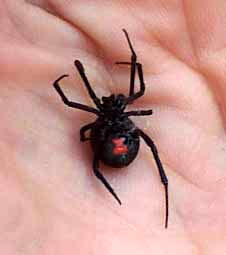Excerpts from Jim Conrad's
Naturalist Newsletter
from the August 31, 2007 Newsletter issued from Sierra Gorda Biosphere Reserve, QUERÉTARO, MÉXICO
BLACK WIDOW
 When Pancho came to my door carrying a glass jar with something in it I knew that another Newsletter entry was brewing. Inside the jar was a Black Widow Spider, the red hourglass figure on the bottom of her black abdomen strikingly visible, as you can see at the right.
When Pancho came to my door carrying a glass jar with something in it I knew that another Newsletter entry was brewing. Inside the jar was a Black Widow Spider, the red hourglass figure on the bottom of her black abdomen strikingly visible, as you can see at the right.
Black Widows are North America's most venomous spiders, but they inject little poison, and seldom bite humans unless they're provoked, as by lying on one or putting on clothing containing one.
By saying "Black Widow Spider" I'm referring to any of about six species of the genus Latrodectus. Pancho's find was probably LATRODECTUS MACTANS, the same one native to the eastern and central US. Widows occur in most of the world's warm spots. Buguide.Net has a page describing differences among the Black Widow species.
I didn't want to release the widow back onto the Reserve grounds so I placed her in a plastic cup with a few Guácimo leaves and with a top on it, and put the cup aside until I could take a walk. A few hours later Silviano came with the widow's egg sac, which Pancho had left behind, so I dropped the sac into the cup as well.
In late afternoon I walked down to the reservoir with my cup of spider and egg sac. When I got ready to dump the widow I was amazed to see that she'd suspended her somewhat battered and dirty egg sac among silk strands she'd strung between two Guácimo leaf surfaces facing one another so that the sac touched nothing but her silks. Then she'd taken up a defensive position next to it.
Instead of dumping the lady I carefully nestled the cup horizontally between rocks in a collapsed stone wall and placed a flat rock over it as a roof.
A lot more information about black widows can be found at http://www.desertusa.com/july97/du_bwindow.html.